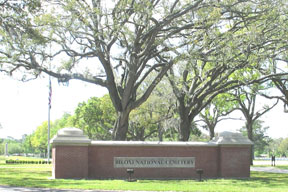|
Biloxi National Cemetery
P.O. Box 4968
Biloxi, MS 39535-4968
Phone: (228) 388-6668
FAX: (228) 523-5784
|
Office Hours:
Monday thru Friday 8:00 a.m. to 4:30 p.m.
Closed federal holidays except Memorial Day.
Visitation Hours:
Open daily from dawn until dusk.
|
|

|
Burial Space:This cemetery has space available to accommodate casketed and cremated remains.
Acreage: 54.1
Number of Interments
Thru Fiscal Year 2007: 16,617
General Information Kiosk on Site? Yes
Floral/Ground Regulations
|
|
Directions from nearest airport:
Directions from Gulfport/Biloxi International Airport: Biloxi National Cemetery, take I-10 East to Exit 46 A (Biloxi /Keesler Air Force Base) onto I-110 South. Take Exit 1B (Gulfport-West). Go west on Highway 90, exactly three miles and stay in the right lane. Turn right on Veterans Avenue, go through one signal light and enter VA property. Take the first road on the right after coming in the main entrance and you will be at the Biloxi National Cemetery.
|
GENERAL INFORMATION
The cemetery serves over half a million veterans in Mississippi, Louisiana and Alabama. Over 800 burials are conducted each year or approximately four per weekday.
back to top
HISTORICAL INFORMATION
Biloxi National Cemetery is located in Harrison County, about five miles west of the center of Biloxi on the grounds of the Department of Veterans Affairs Medical Center (VAMC) and adjacent to the Keesler Field Air Force Base in Mississippi.
The cemetery was established in March 1934 as part of the VA Medical Center. Biloxi Cemetery’s first burial was held on March 24,1934, with the interment of Private Edgar A. Ross, 1st Regiment of the Tennessee Infantry.
From 1934 to 1973 the purpose of Biloxi Cemetery was to provide a final resting place solely for veterans who died in the adjoining medical center. The allocation of cemetery space in Biloxi remained restricted until the passage of the 1973 National Cemetery Act, which opened the cemetery to all honorably discharged veterans and their dependents, active duty personnel and their dependents regardless of home of residence or where death occurred. The first interment after the facility was designated Biloxi National Cemetery was Chief Master Sergeant Robert E. Callender, U.S. Air Force.
Since its establishment in 1934, Biloxi’s has increased in size twice as the result of land transfers from the VAMC. In 1982, 17 acres were added to the original 25 and, in 1996, 12 more were added for a total of 54 acres.
Monuments and Memorials
Biloxi National Cemetery Monument is approximately 30 feet tall and 10 feet in diameter; it was erected in May 1941 to commemorate all who have served their country.
A square granite marker located in front of the Administration Building was donated by the National Association of Atomic Veterans on Nov. 9, 1990, in memory of veterans who participated in the U.S. nuclear weapons testing program.
A memorial plaque with an original poem by First Lieutenant William S. Haynie, U.S. Marine Corps, titled "This Hollowed Place" was donated in conjunction with American Legion Post 119 in Gulfport, Miss.
back to top
NOTABLE PERSONS
Medal of Honor Recipients
Colonel Ira C. Welborn (Spanish American War), 9th U.S. Infantry. Santiago, Cuba, July 2, 1898 (Section 12, Row 4, Grave 12).
Others
More than 130 years after their death on Greenwood Island near Pascagoula, Miss., and 10 years after they were disinterred, two unknown Mexican War soldiers of Twiggs Brigade were laid to rest with full military honors on Veterans Day November 11, 1989.
They were found in side-by-side coffins, exposed by erosion, on a 1840s military reservation known as Camp Jefferson Davis. The camp was named for the Mississippi Mexican War hero who later lead the Confederacy. They are located in Section H, graves 4 and 5.
back to top
FLORAL/GROUNDS REGULATIONS
Cemetery policies are conspicuously posted and readily visible to the public.
Floral arrangements accompanying the casket or urn at the time of burial will be placed on the completed grave. Fresh flowers may be placed on graves at any time. Use floral containers provided by the cemetery. They will be removed when they become unsightly or when it becomes necessary to facilitate cemetery operations such as mowing.
Artificial flowers and potted plants will be permitted on graves during the period of Oct. 10 through Feb. 28, and 10 days before through 10 days after Easter Sunday and Memorial Day.
Permanent plantings, statues, vigil lights, breakable objects of any kind, and similar commemorative items are not permitted on graves at any time.
Christmas flowers, wreaths, and/or grave blankets are permitted on graves during the Christmas season and will be removed not later than Jan. 20 of each year. Grave floral blankets may not be larger in size than two feet by three feet.
Floral items and other types of decorations will not be secured to headstones or markers.
Permanent in-ground flower containers are not authorized for placement in any burial section established after 1973. Flower containers are available and can be found throughout the cemetery in black containers with VASES on the side of the container.
back to top
|


